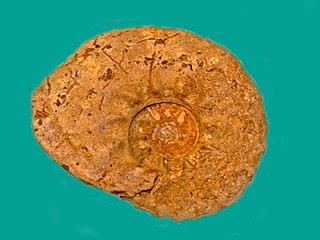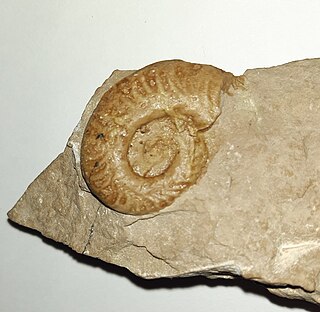
Australiceras is an extinct ammonite genus from the upper part of the Early Cretaceous, Aptian stage, included in the family Ancyloceratidae.
Karapadites is an extinct ammonoid genus belonging to the desmoceratacean family Kossmaticeratidae and considered by some to be a subgenus of Kossmaticeras.

Xipheroceras is a Lower Jurassic ammonite belonging to the Eoderoceratidae, and sometimes placed in the subfamily Xipheroceratinae for which it is the namesake. It has been found in the upper Sinemurian of Europe and possibly Borneo.

Aspidoceras is an extinct ammonoid cephalopod genus belonging to the family Aspidoceratidae.
Astiericeras is an ammonite from the Lower Cretaceous, the shell of which is evolute, stout; outer whorl with strong, well spaced, transverse ribs that cross smoothly over the broad venter; early whorls with lateral tubercles. The outer, mature whorl separates from the coil but hooks back quickly, referred to as a heteromorph.

Argonauticeras is an extinct ammonoid cephalopod genus that lived during the latter part of the Early Cretaceous, included in the Lytoceratida and found in lower and possibly middle Aptian marine sediments. It has been thought of as a subgenus of Ammonoceratites.
Balticeras is an involute, discoidal Upper Jurassic (Oxfordian) ammonite found in England, Germany, and Switzerland, belonging to the Perisphinctidae. The shell is strongly embracing, tending to be oxyconic. Sides are gently curved, converging on a narrow to sharp ventral rim.

Barroisiceras is an acanthoceratacean ammonite from the Upper Cretaceous, Coniacian, included in the family Collignoniceratidae.
Benacoceras is a strongly ribbed, evolute ammonite from the Late Jurassic, coiled so that all whorls are exposed. Ribbing is biplicate, with very short secondaries. The venter, the outer rim, is smooth, at least on the outer whorl.
Zaraiskites is an extinct genus of ammonoid cephalopod that lived during the Tithonian.
Oecotraustes is an extinct cephalopod genus included in the ammonid family Oppeliidae and named by Wilhelm Waagen in 1869. Species in the genus lived during the Middle Jurassic.

Hildoceras is a genus of ammonite from the Jurassic period in the family Hildoceratidae. The shells are characterized by a narrow discoidal evolute shape, keeled venter, concave ribs along the outer flanks, and a shallow spiral groove running along smooth inner flanks. Whorls slightly overlap, cross sections are compressed. The ventral keel is bordered on either side by a shallow groove. The genus was named by Alpheus Hyatt after Saint Hilda in 1876.

Peltoceras is an extinct ammonite genus from the aspidoceratid subfamily Peltoceratinae that lived during the later part of the Middle Jurassic.
Eoderoceras is an evolute, round whorled ammonite from the Lower Jurassic with an outer row of distinct spines, and in some, an inner row of tubercles, on either side; ribs only on the inner whorls.
Crucilobiceras is an ammonoid cephalopod genus from the Lower Jurassic belonging to the eoderoceratoidean family Eoderoceratidae. Cruciliboceras has an evolute shell, such that all whorls are well exposed, with persistent radial ribbing and with spines or tubercles on the outer, ventral, rim, and in some, tubercles in the inner, umbilical, rim. The genus Crucilobiceras is commonly found along the Jurassic Coast of England.

Kepplerites is a moderately evolute ammonite from the lower Callovian included in the Stephanoceratoidea.
Melchiorites is a desmoceratid ammonite genus included in the subfamily Puzosiinae. Member species are characterized by an essentially evolute shell in which the early whorls are smooth, with sinuous radial or oblique constrictions but in which later whorls have feeble intermediate ribs on the outer part of the sides and venter.
Dasyceras is an early phylloceratid from the Sinemurian stage of the lower Jurassic, found in Europe.
Dayiceras is a finely ribbed polymorphitid eoderoceratacean ammonoid cephalopod from the Jurassic, named by Spath in 1920. The shell is evolute, coiled such that all whorls are exposed. The whorl section is compressed such as to be higher than wide. A row of fine tubercles runs along the middle of the outer rim, the venter.

Hammatoceras is a genus of ammonites belonging to the family Hammatoceratidae which lived during the Toarcian stage of the Early/Lower Jurassic between about 184 and 175 million year ago.








